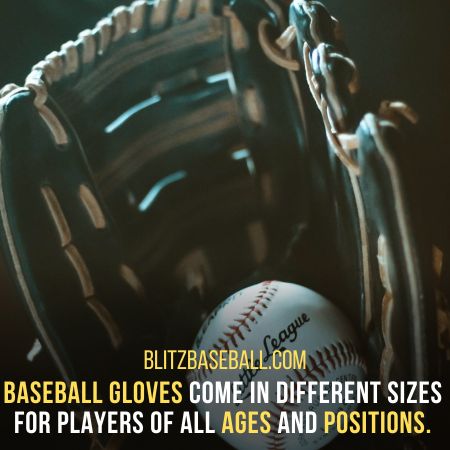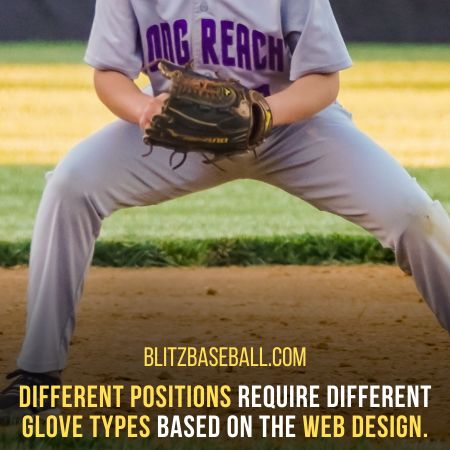Choosing the right baseball glove size is crucial for players of all ages and positions. The size of the glove is determined by factors such as the player’s position and age.
Infielders, outfielders, first basemen, pitchers, and catchers all require different glove sizes to optimize their performance on the field. For example, infielders typically use gloves ranging from 11 inches to 12.25 inches, while catchers use mitts ranging from 32.5 inches to 34 inches.
Additionally, youth players have specific glove sizes based on their age. It is important to select the appropriate glove size for comfort and functionality, as different positions and ages have specific requirements.
This article will provide a comprehensive guide on what size baseball glove do I need on positions and ages, as well as discuss the different types of glove webs available.
Key Takeaways
- Baseball gloves come in different sizes for players of all ages and positions.
- Different positions require different glove types based on the web design.
- The size of a baseball glove is measured in inches.
- The baseball glove size chart by age provides a guideline for choosing the right glove size.
What Size Baseball Glove Do I Need?
Choosing the right size baseball glove is crucial in ensuring comfort and optimal performance on the field, as it allows players to have a secure grip and effectively field the ball based on their position and age. To determine the appropriate glove size, players can refer to a fitting guide or use measuring techniques.
When measuring glove size, it is important to consider both the width and length of the hand. Additionally, players should take into account their position on the field, as different positions require different glove types.

Infielders typically use gloves ranging from 11 inches to 12.25 inches, while outfielders use gloves ranging from 12.5 inches to 12.75 inches. First basemen require mitts ranging from 12 inches to 13 inches, while pitchers use gloves ranging from 11.5 inches to 12.5 inches. Catchers, on the other hand, use mitts ranging from 32.5 inches to 34 inches.
By selecting the appropriate glove size, players can enhance their overall performance and enjoy a comfortable fit.
Different Positions and Gloves
Different positions in baseball require specific types of gloves based on the design of the web. The web design of a glove refers to the pattern of the leather that connects the fingers and the thumb. It plays a crucial role in determining the functionality and performance of the glove.
Here are five different web designs commonly used in baseball gloves:
-
I-Web: This web design features a single strip of leather that runs vertically down the middle, creating a small pocket ideal for infielders.
-
Modified Trapeze Web: This web design has a shallow pocket with a small opening, suitable for outfielders who need to quickly release the ball.
-
Two-Piece Web: This web design consists of two pieces of leather connected by laces, providing flexibility and control for pitchers.
-
H-Web: This web design forms an ‘H’ shape with leather strips, offering a deeper pocket for outfielders to catch fly balls.
-
Single Post Web: This web design has a single vertical strip of leather, commonly found in first baseman’s mitts for easy ball retention.
When considering glove options, infielders often recommend gloves like the Wilson A2000 and Rawlings Heart of the Hide for their quality and durability.
Youth Baseball Glove Sizes
Youth baseball players typically require gloves ranging from 9 inches to 11.5 inches in length, depending on their age.
For 5-year-olds, glove sizes range from 9 inches to 10 inches, while 8 to 10-year-olds would need gloves between 10.75 inches and 11.5 inches. The recommended glove size for 12-year-olds is 12 inches.
It is important to choose an age-appropriate glove size to ensure comfort and proper hand fit.

Additionally, breaking in and maintaining youth baseball gloves is crucial for optimal performance. Breaking in the glove involves softening the leather and shaping it to the player’s hand. This can be done by applying glove oil or conditioner and repeatedly flexing the glove.
It is also important to keep the glove clean and dry after each use to prevent damage and prolong its lifespan. Regular maintenance and care will help youth players develop a strong bond with their gloves and enhance their performance on the field.
Types of Baseball Glove Webs
One of the key factors to consider when selecting a baseball glove is the type of web design it features. The web design of a glove refers to the pattern of leather that forms the pocket where the ball is caught.
Different types of web designs offer various benefits and are suited for different playing styles.
Benefits of different types of baseball glove webs:
-
I-Web: Provides a clear view of the ball while offering good support and stability.
-
Modified Trapeze Web: Offers a deeper pocket for secure ball-catching and enhanced ball control.
-
Two-Piece Web: Allows for quick ball transfer from glove to hand, ideal for infielders.
-
H-Web: Provides a larger surface area for catching fly balls and offers good visibility through the web.

To choose the right web design for your playing style, consider factors such as the position you play, the type of ball you catch, and your personal preferences for visibility and control. Experimenting with different web designs can help you find the one that suits you best.
Frequently Asked Questions
What are some recommended brands for baseball gloves?
Some recommended brands for baseball gloves include Wilson and Rawlings. Wilson offers the a2000 series and Rawlings offers the heart of the hide series. When considering synthetic vs leather gloves, pros of synthetic gloves include durability and affordability, while pros of leather gloves include better feel and break-in ability.
How do I properly break in a catcher’s mitt?
The proper way to break in a catcher’s mitt involves using the best materials, such as glove conditioner or oil, to soften the leather. This process helps to shape the pocket and make the glove more comfortable and responsive.
Are there any specific guidelines for choosing a left-handed baseball glove?
When choosing left-handed baseball gloves, it is important to consider the player’s position and age. Left-handed players have an advantage in baseball as they can easily make throws and field balls without having to switch hands.
Can I use the same glove for multiple positions?
Using one glove for multiple positions has advantages and disadvantages. The advantage is cost-effectiveness, as you don’t need to buy multiple gloves. However, it may not provide the best fit and performance for each position’s specific needs.
Are there any regulations regarding baseball glove sizes in professional baseball?
Regulations on baseball glove sizes in professional baseball dictate that gloves must not exceed a certain size. The impact of glove size on performance varies among positions, with infielders typically using smaller gloves for better control and outfielders using larger gloves to catch fly balls more easily.
Conclusion
In conclusion, choosing the right size baseball glove is crucial for players of all ages and positions.
Player’s positions determine the appropriate glove size, ranging from 11 inches for infielders to 34 inches for catchers.
Youth players also have specific glove sizes based on their age.
It is important to consider comfort and performance when selecting a glove size.
By understanding the different positions and age requirements, players can find the perfect glove size to enhance their performance on the field.
